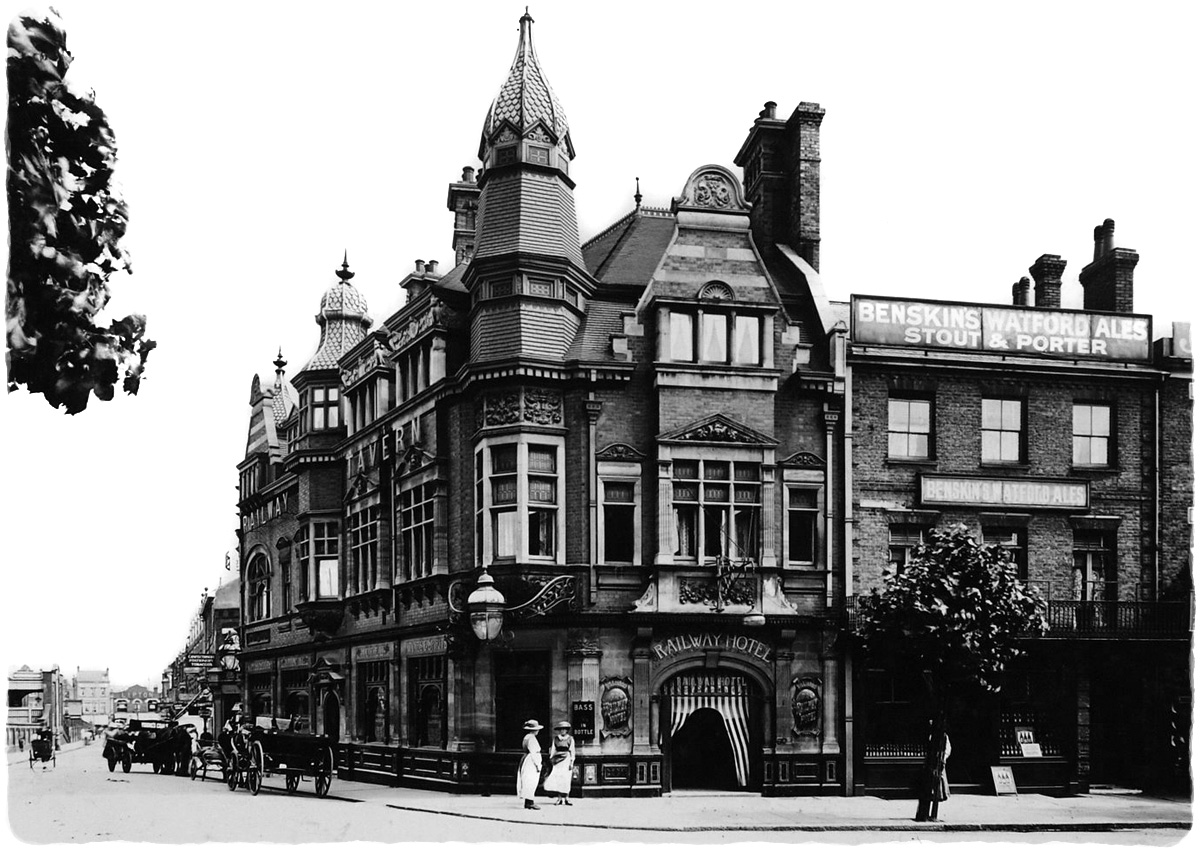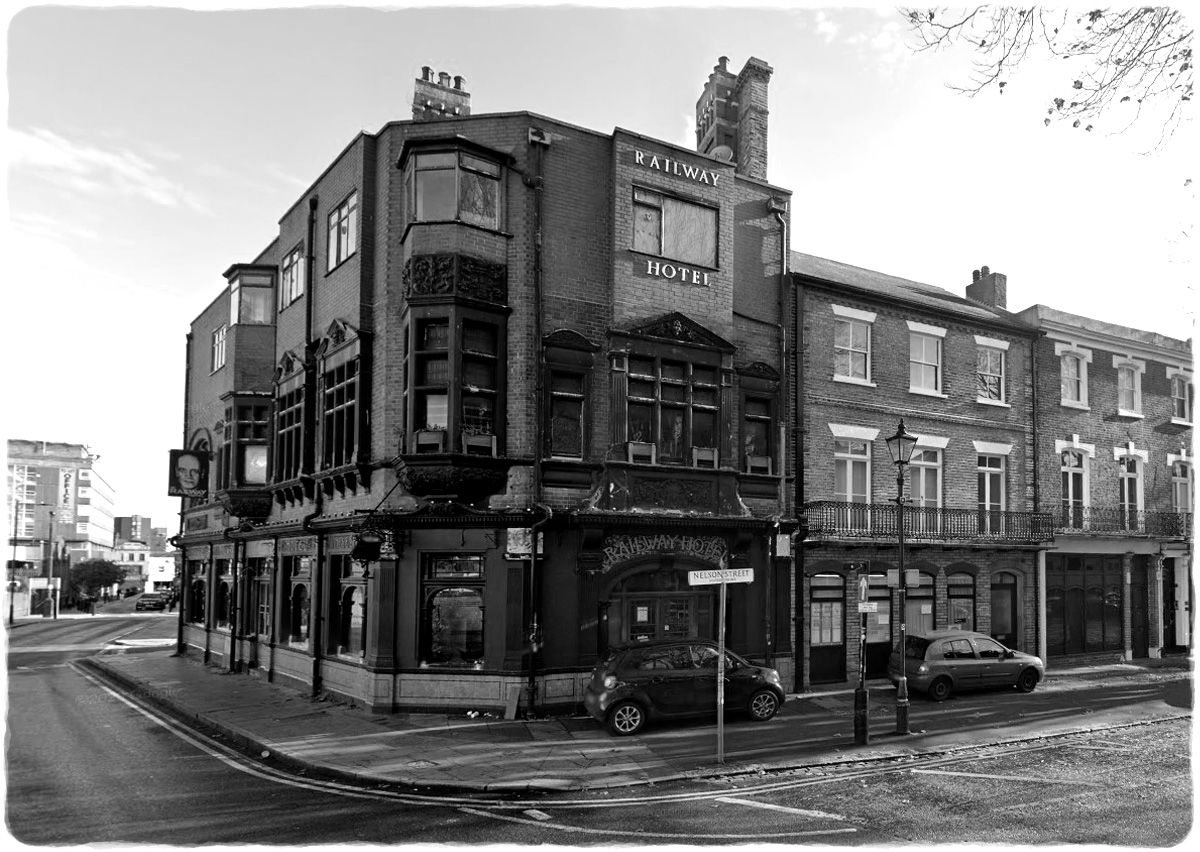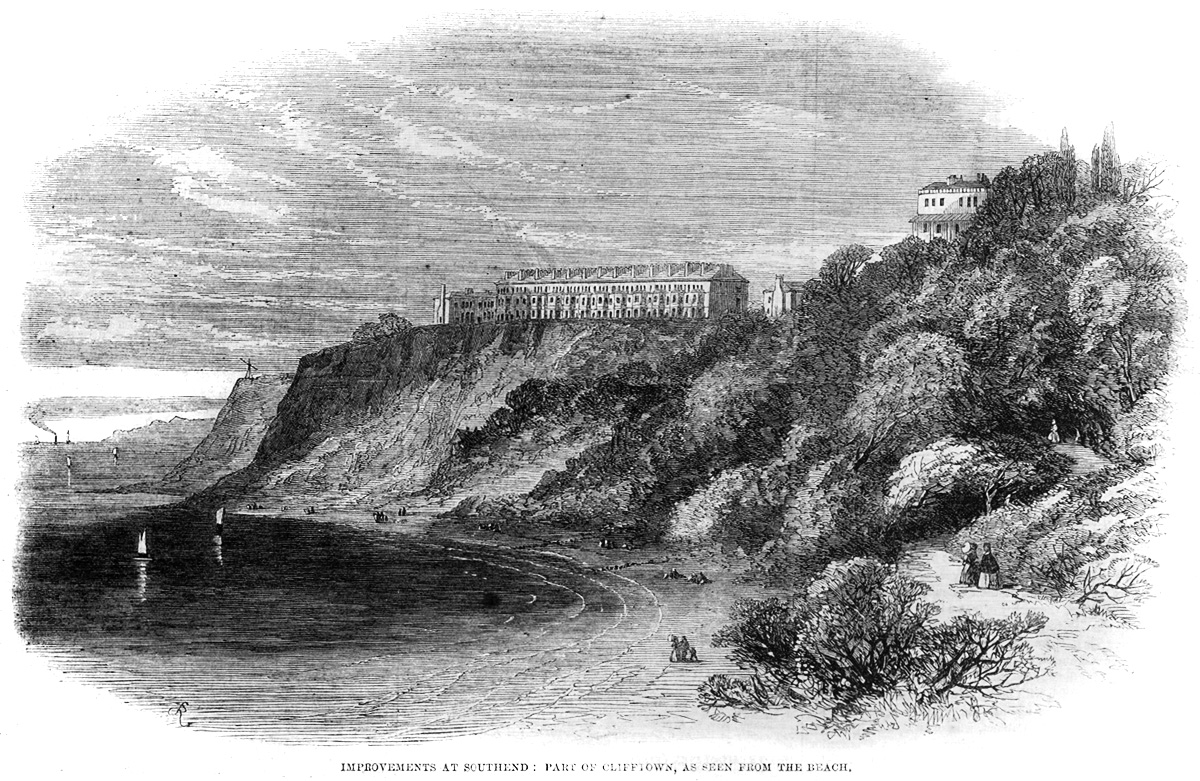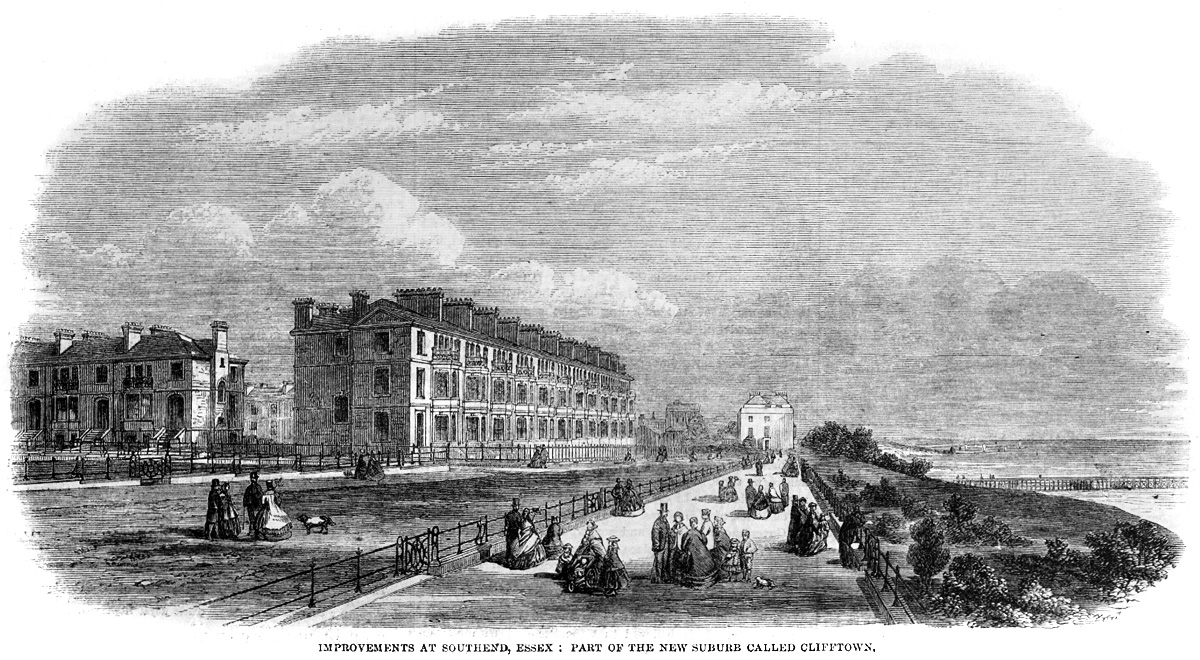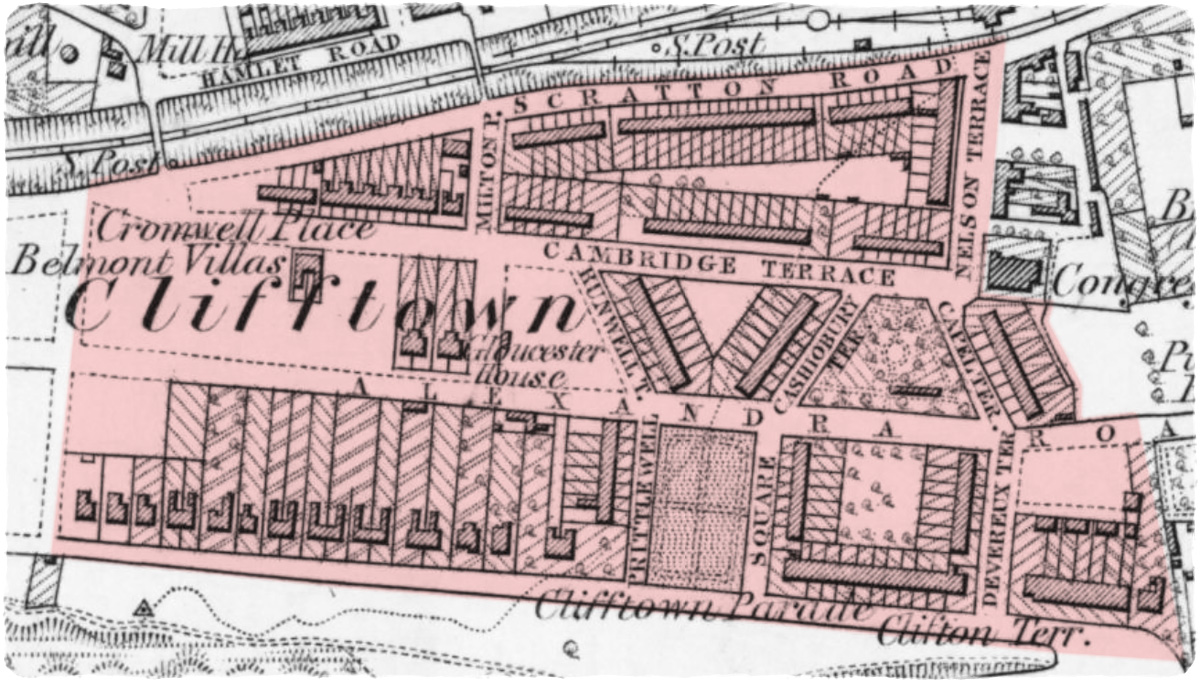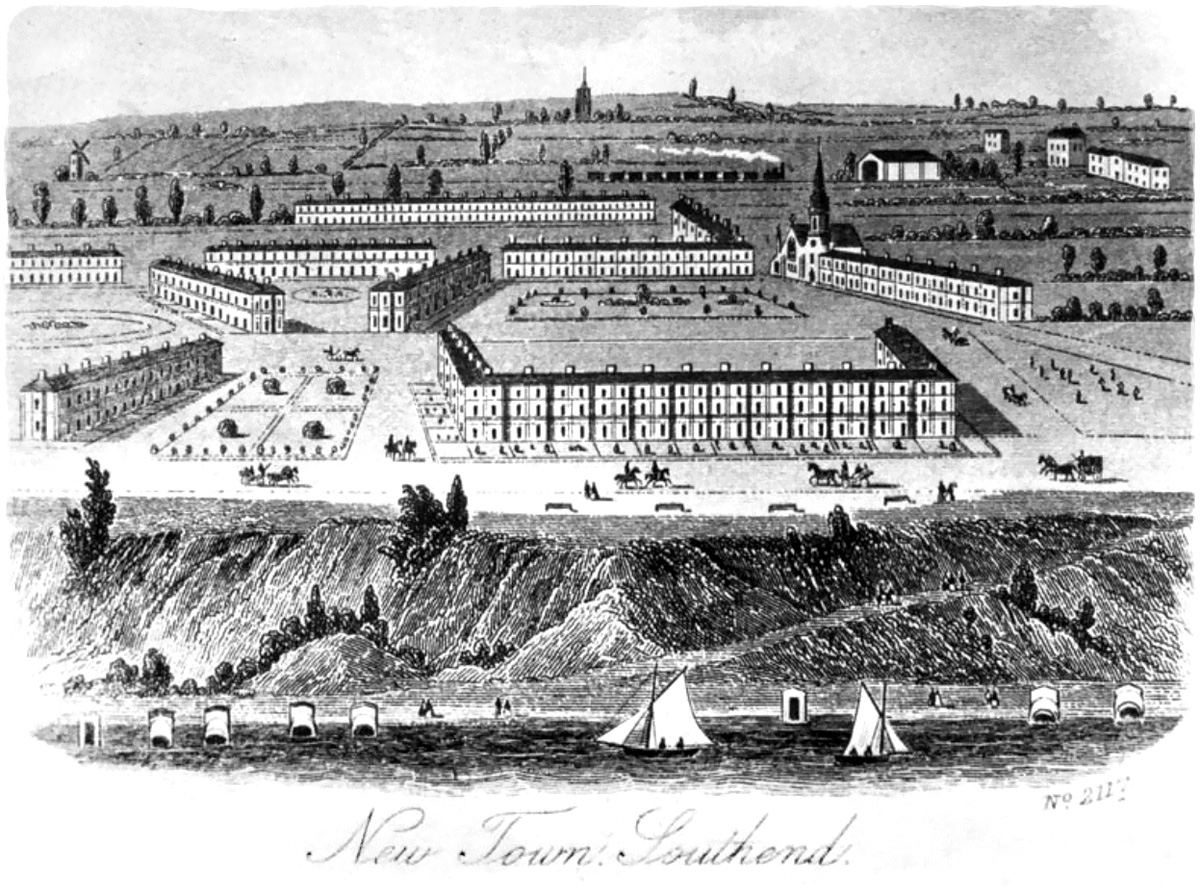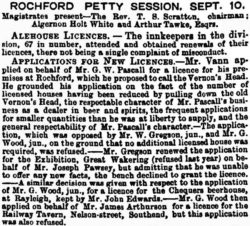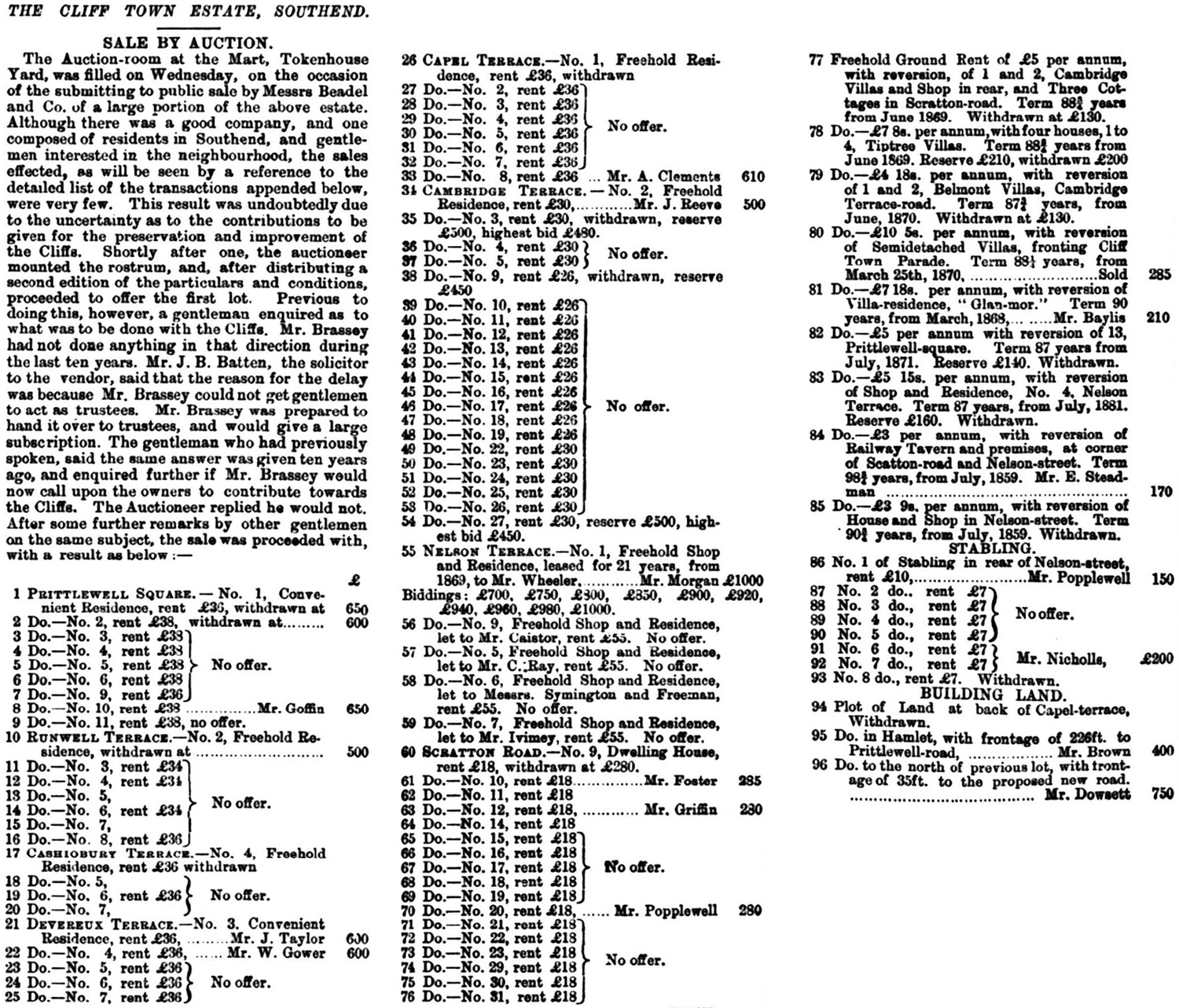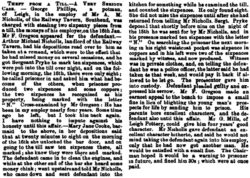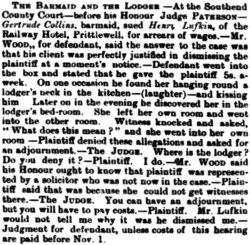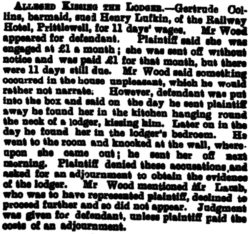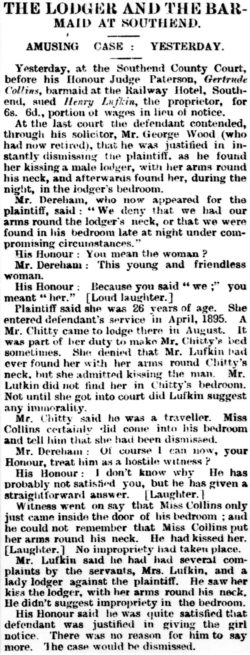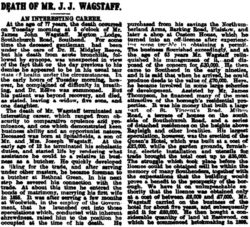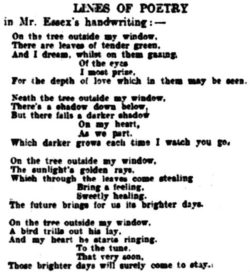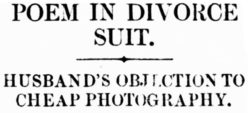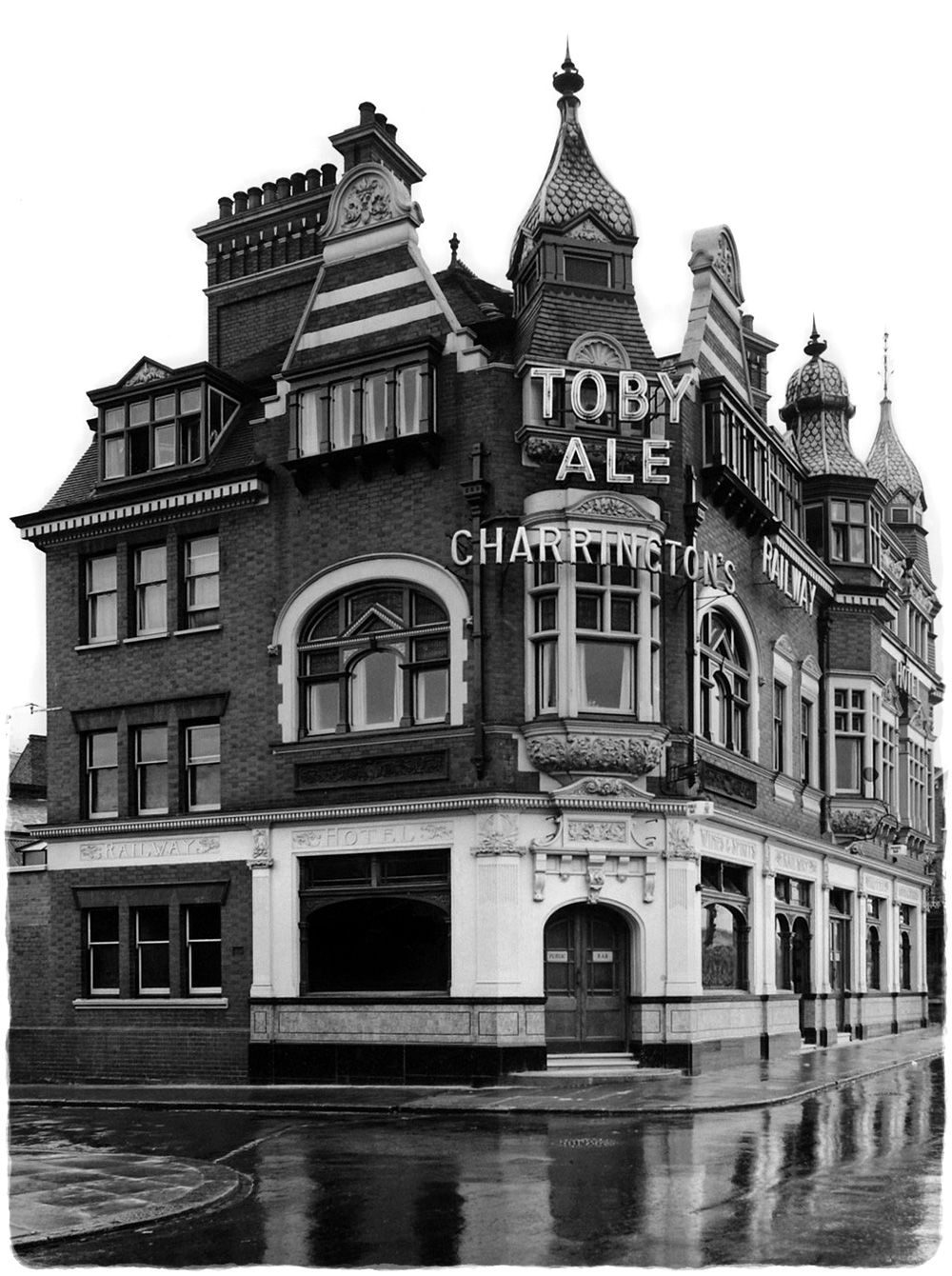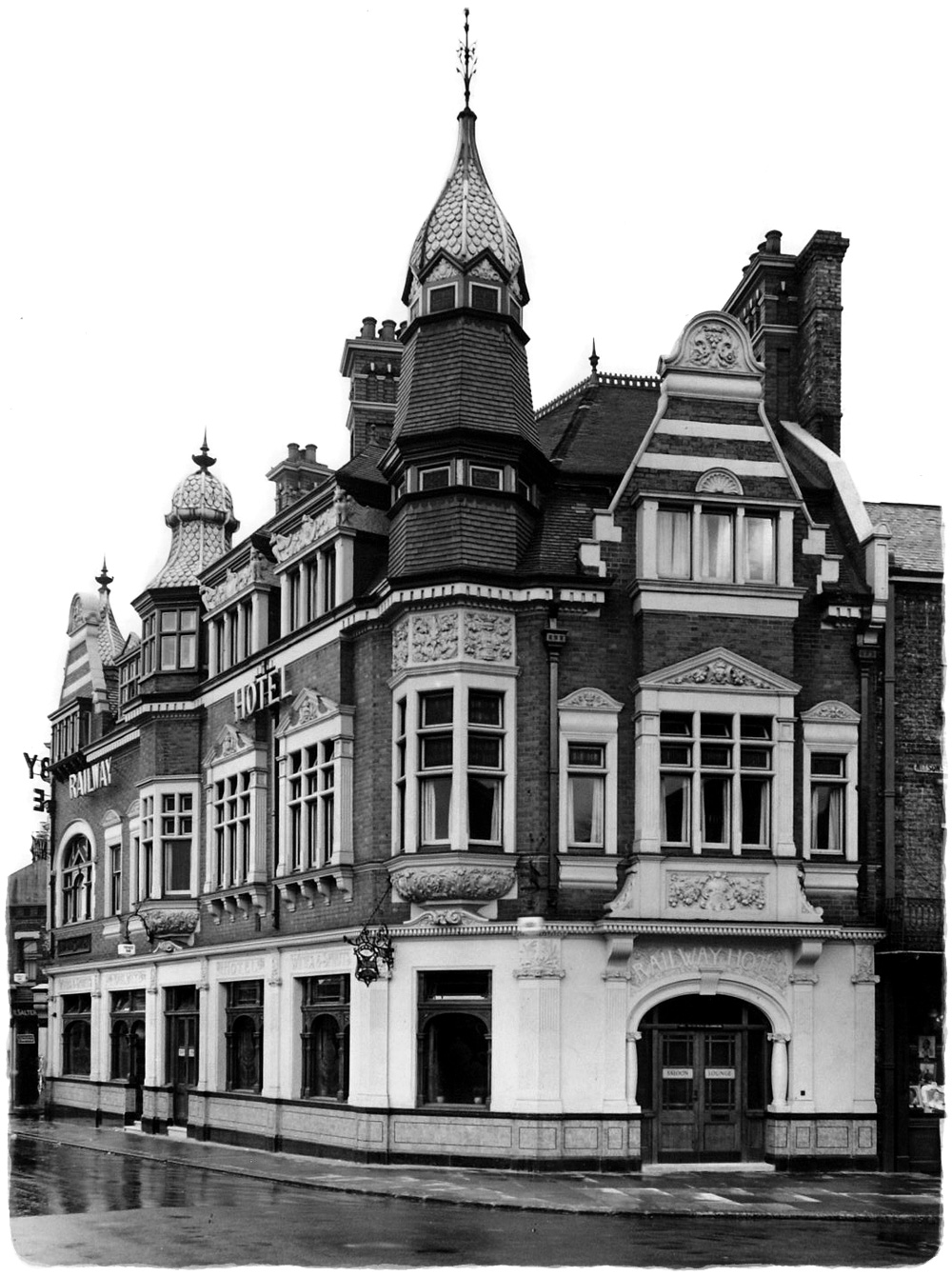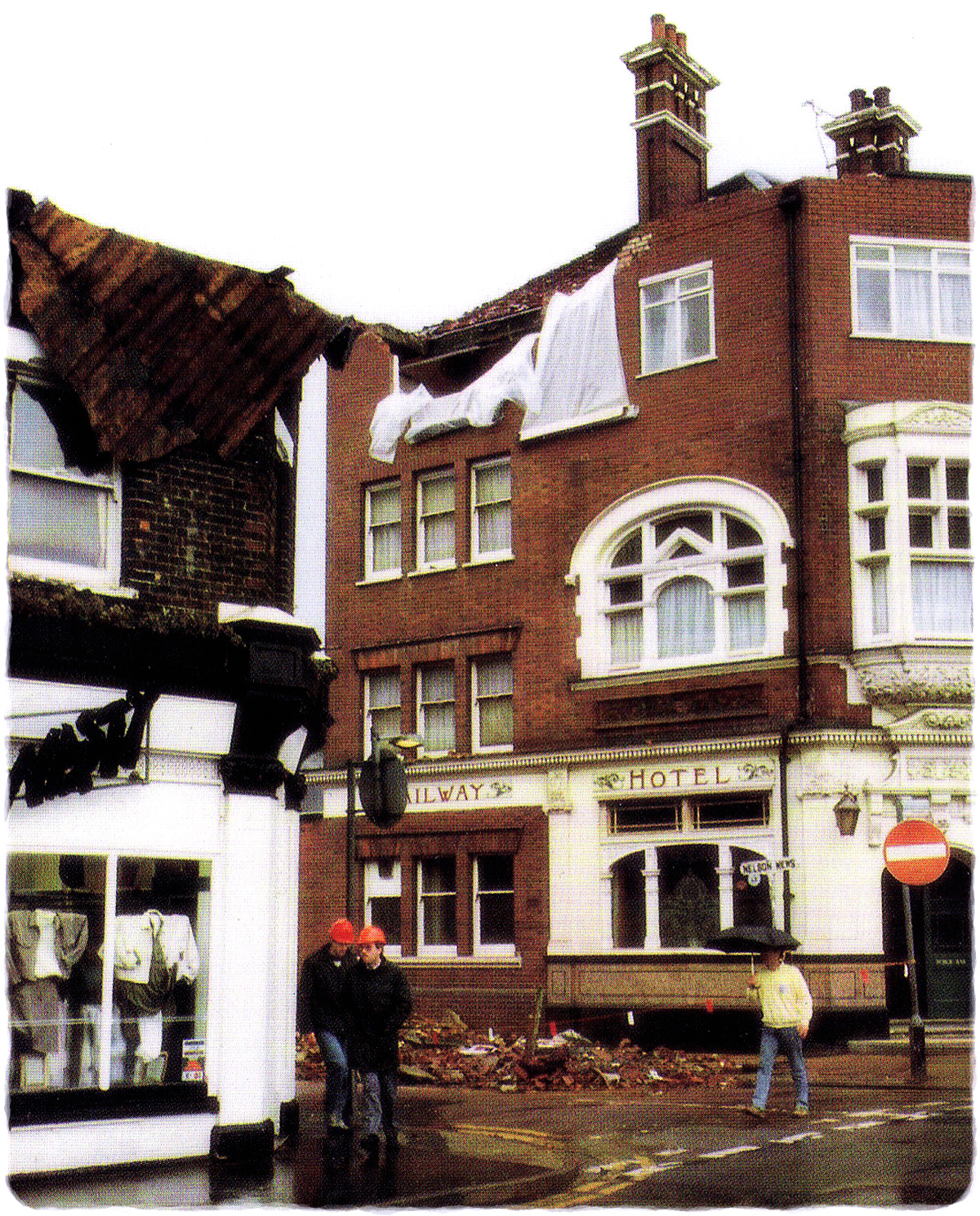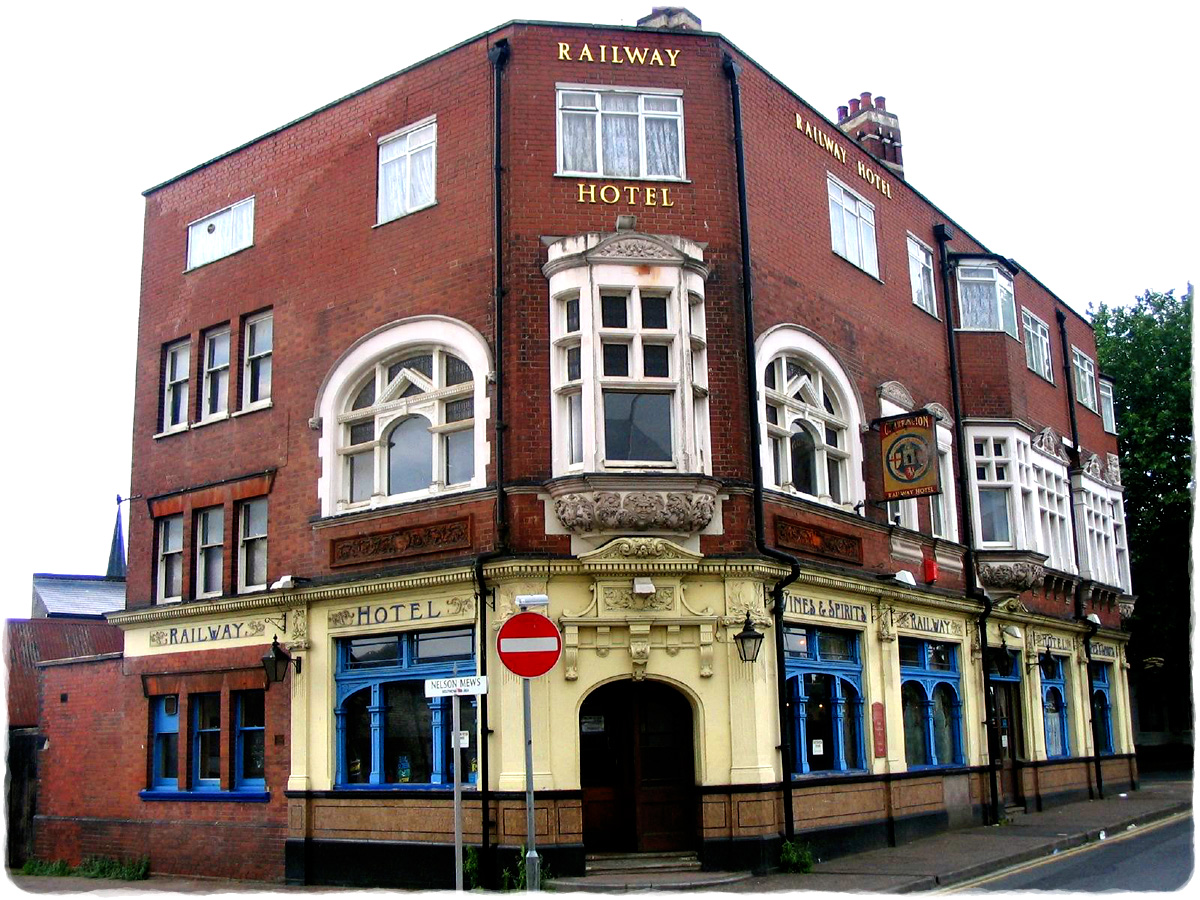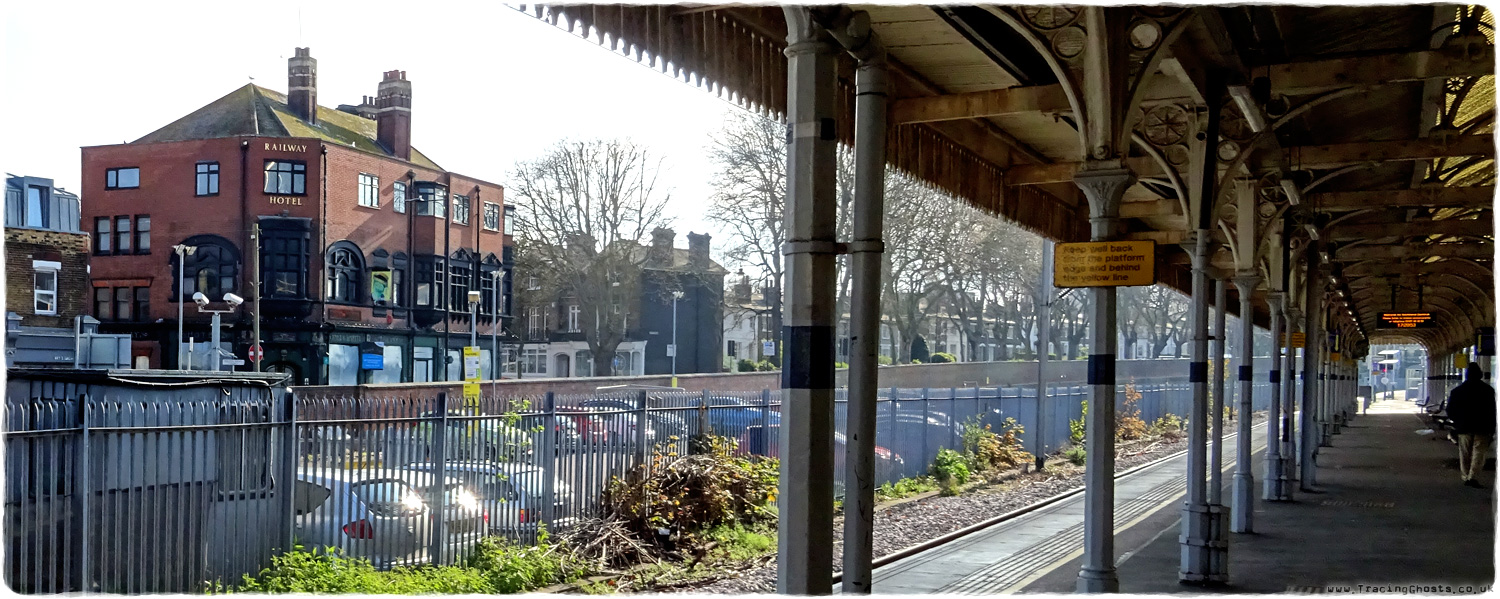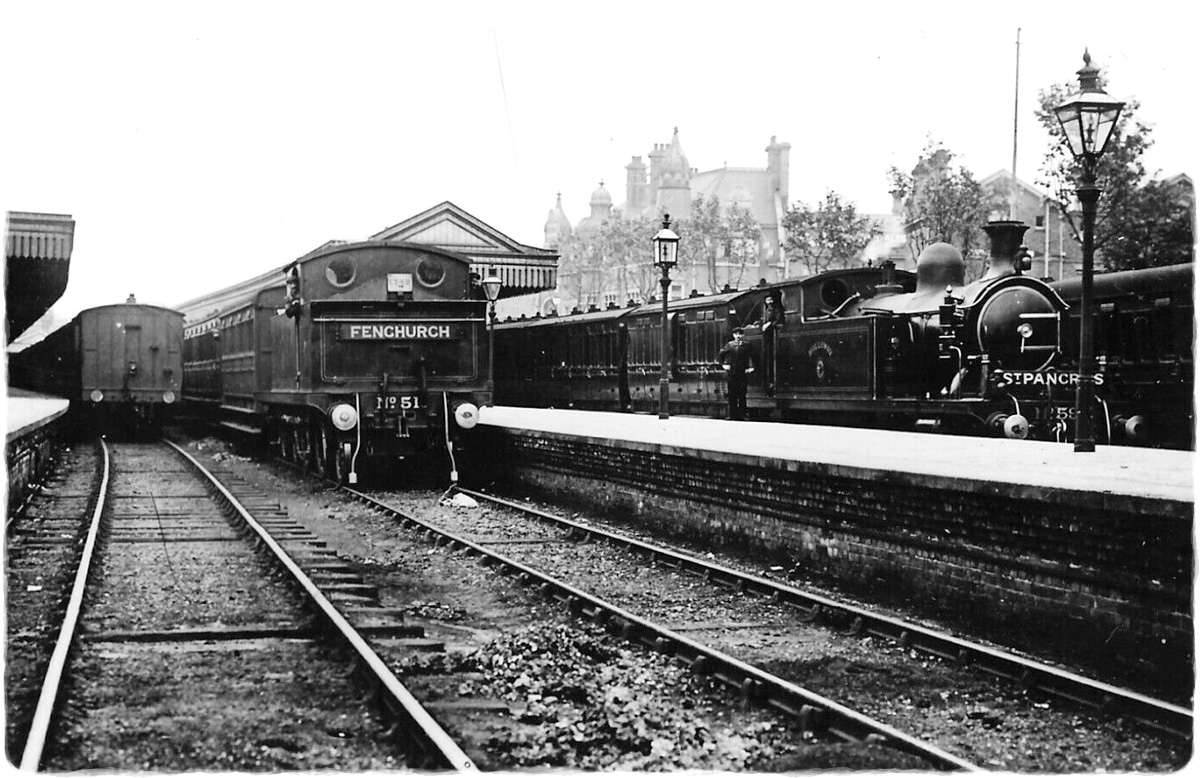The History of the
Railway Hotel
Clifftown Road, Southend-On-Sea, Essex
The Railway Hotel is situated at the end of Clifftown Road, in the Cliff Town Conservation Area of Southend-On-Sea, Essex. The building and business date from circa 1868 and traded almost continually until a four-year closure that began in April 2021. It finally reopened its doors in October 2025.
Originally called the Railway Tavern, the pub was addressed as Nelson Street, onto which it also abuts. Nelson Street was built between 1859 and 1861 and was designed as Southend’s first shopping area, predating the development of the High Street. It would have been a bustling location, with the newly opened railway station situated directly across the road—a prime site for a hotel and public house.
The striking photograph to the left was taken in 1919 by Charrington Brewery and is one of hundreds of pub images saved from a skip in the 1970s (all of which can be seen on Flickr, thanks to the National Brewery Heritage Trust). Note the lettering “RAILWAY TAVERN” across the front of the building, with “RAILWAY HOTEL” above the door. The building no longer features the Dutch gables or ornate turrets (as seen in the photo on pg.21 from 2021), but very similar gables can still be found further along Clifftown Road at numbers 21-25. This stretch of terraces (originally six, now five) shares similar decorative features above the windows.
- Railway Hotel, 1919 (thanks to the National Brewery Heritage Trust)
- Railway Hotel, 2021 (thanks to Google Maps)
Properties along Clifftown Road were built between 1881 and 1891, following the emergence of the High Street. Numbers 21-25 were a later addition, constructed on the final vacant plot sometime between 1895 and 1901. From 1897 to 1899, the Railway Hotel underwent several alterations, including the addition of roof decorations and changes to its façade.
Further internal refurbishment took place during the interwar years, carried out by Charrington Brewery, along with some minor exterior updates. The most significant external change, however, was the complete transformation of the roofline—the removal of the turrets and gables, and the extension of the wall above the second floor to create a more level appearance from the street.
A 28-page research booklet is available to buy here.
- The History of Railway Hotel, Southend-On-Sea, Essex
The History and Development of Cliff Town
From the late 17th century onwards, the SCRATTON family owned many hundreds of acres of farmland around Southend and Prittlewell, including Prittlewell Priory and Milton Hall (the late Nazareth House). The 1841 tithe records for Prittlewell list John Bayntun SCRATTON as the owner and occupier of over 2,000 acres of land, including the area that would become Cliff Town in 1859. John’s son, Daniel, inherited his father’s estate upon his death in 1842.
The Southend to Tilbury railway line was completed in 1854 by Sir Samuel Morgan PETO, Thomas BRASSEY and Edward BETTS. The following year, they built the Grand Crimean Central Railway, a supply and casualty transport route used during the Crimean War. Southend gained gasworks in 1855, followed by waterworks from 1856.
On 1st July 1859, Sir Samuel Morgan PETO signed a 99-year lease for 40 acres of land in Southend belonging to Daniel Robert SCRATTON, stretching from the new railway line down to the shore, covering land called Shorefield and Millfield. Peto, Brassey and Betts, along with builder brothers Charles LUCAS and Thomas LUCAS and architects BANKS & BERRY, went on to design the new Cliff Town development in Southend and laid the first stone four months later on 3rd October 1859.
On 1st June 1861, the Illustrated London News ran a full-page article on the nearly completed suburb, accompanied by two charming illustrations:
“The accompanying illustrations represent the new suburban town on the cliff at Southend, Essex, which had been projected and carried out by Sir Morton Peto, Mr. Brassey, and other large contractors, and which is now all but completed. Clifftown consists of 124 houses, which have been erected at a total cost of above £100,000, and it is proposed that persons desiring to occupy them may either become tenants at a fixed rent, or may gradually assume proprietorship by the payment of annual sums over a period of years. The views of the opposite coast of Kent are beautiful from here ; and the constant passing of vessels up and down the mouth of the Thames to and from all parts of the world gives life and variety to the prospect. It is stated that arrangements have been entered into with the Tilbury and Southend Railway Company to run express-trains to and from London and Southend within an hour and a quarter, and also to issue season tickets and reduced rates. The enterprise has been carried out with great spirit, and we trust it may be successful, as it helps to supply a want which the overworked middle classes of London experience.”
Newspaper articles throughout are reproduced with the permission of the British Newspaper Archive and The British Library Board.
- Illustrated London News – Saturday 01 June 1861
- Illustrated London News – Saturday 01 June 1861
The completed 124 houses were advertised in March 1861 as ready to let, offering “unrivalled views of the sea and the opposite coast.” Their water was supplied by the newly constructed Southend Water Works, and the streets were lit by gas. The properties were arranged into three classes, differing in size, proportion and rental cost. By 1862, most of the houses were occupied. They comprised:
- Twelve houses in one terrace facing the sea, with fourteen rooms each
- Forty-five houses in six terraces, each with ten room
- Twenty-seven houses in three terraces, each with seven rooms
- Additional houses in six terraces, each with six rooms
- Eight houses in one terrace built as shops, with ten rooms and two storerooms each (on the west side of Nelson Street)
The map on the left (surveyed in 1873) highlights the original Cliff Town area. The Congregational Church, shown in the right-hand illustration, was built in 1865. At that time, the east side of Nelson Street (marked as Nelson Terrace on the map) and the Railway Hotel at the top had yet to be constructed. Both were erected by 1867, and the pub’s first landlord was James ARTHURSON. The identity of the builder remains unknown.
Maps reproduced with the permission of the National Library of Scotland.
- Map Surveyed 1873 & Published 1880
- Cliff Town Estate c.1865
LICENSEES AND OWNERS
Using census and electoral records, directories and newspaper articles, it has been possible to uncover nearly 100 years of occupancy at the Railway Hotel, from 1868 to 1962. The licence changed hands many times over the course of these ten decades.
James ARTHURSON
(Licensee, 1868-1873)
James ARTHURSON was the first licensee and landlord of the newly built Railway Tavern from 1868.
Born in Lerwick, Sheland, Scotland, on Christmas Day 1817, James was the son of a cooper of the same name. He joined the Royal Navy in 1838, having already spent time at sea, and also worked as a cooper like his father.
James married the recently widowed Eliza SWADEN (née STEDMAN) on 16th December 1856. At this time, he was still serving in the Navy and residing in Minster, Isle of Sheppey, Kent. Eliza had been born in Northfleet, Kent, in 1813. Before marrying James, she had wed John SWADEN on 23rd April 1837 in London. When the 1841 census was taken, they were both working as servants for a sugar refiner and living in Goodmans Fields near Whitechapel.
By 1855, the couple had moved to the Old Jolly Sailor at 16 West Street, Blue Town, Kent. John died the following year, on 5th May 1856, aged 52, after a lingering illness. They had no children. A few months later, Eliza—now age 43—married James, just a few days before his 39th birthday.
While James was away with the Navy, Eliza continued to run the Old Jolly Sailor until his discharge in July 1860. The couple then managed the pub together until 1867, when they moved to Southend. They did not have any children together.
James applied for a new licence to the Railway Tavern on 10th September 1868, but was initially refused (as were three other applications). He was clearly successful shortly thereafter, as by the time the 1871 census, James was working as a licensed victualler from the recently built public house. Eliza and one servant (Martha Jane HIDE, aged 14) were also listed as residing there.
- Essex Herald – Tuesday 15 September 1868
By 1874, the couple had moved to 11 Albyn Terrace, Queen’s Road in Southend, where James died on 4th October 1878 aged 61. Eliza died not long after, on 19th March 1880, aged 67. Her probate record names two executors: Edwin STEDMAN, who went on to purchase the Railway Tavern two years later when much of the Cliff Town estate was put up for auction; and Samuel DARKE of 3 Scratton Road, a builder who lived nearby. Samuel was responsible for constructing—either independently or on behalf of others—numerous properties in the local and surrounding area from the 1880s onwards. Although the exact relationship between Eliza and Edwin Stedman cannot be confirmed, they may have been cousins.
Edwin STEDMAN
(Owner, 1882-1897)
Edwin STEDMAN bought the Railway Tavern in 1882 but never lived or worked there.
Born in 1837 in Detling, Kent, Edwin worked for several years as a butler. He married housekeeper Mary KEEN in 1869. The couple had no children. At the time of the 1871 census, the couple were both employed in the same household working for Walter Henry BRACEBRIDGE.
Edwin retired in his early forties to Southend, where he and Mary moved in with Eliza ARTHURSON (née STEDMAN) at 11 Albyn Terrace. It is unclear whether this was before or after the death of Eliza’s husband, James ARTHURSON. Following Eliza’s death in 1880, Edwin and Mary remained at 11 Albyn Terrace and were recorded there in the 1881 census.
Sale by Auction
A large auction was held on 25th October 1882, featuring ninety-three properties in the Cliff Town area, including the Railway Tavern. Only twelve were sold, as many prospective buyers expressed concern over the long-term preservation and improvement of the Cliffs.
The Railway Tavern was acquired by Edwin STEDMAN for £170 (just over £17,000, as of 2024), subject to a freehold ground rent of £3 per year under a lease term of 983/4 years dating from July 1859.
- Southend Standard and Essex Weekly Advertiser – Friday 27 October 1882
By 1885, Edwin and Mary had relocated from Southend to Atherstone, Warwickshire—Mary’s birth county, where they had previously worked for many years. Edwin remained the owner of the Railway Tavern until 1897, when he sold it to James John WAGSTAFF, shortly before his death on 5th June 1900 at the age of 65.
Robert BARRATT
(Licensee, 1873-1875)
Robert BARRATT succeeded James ARTHURSON as licensee of the Railway Tavern in 1873 (or possibly 1872).
He left Southend on 28th January 1875. His popularity in the town was evident, as his departure from the railway station opposite the pub was marked by a farewell attended by the town band and several of Southend’s leading tradesmen. Regrettably, no further details about his background or life have been uncovered.
Following Robert’s departure, the band returned to the Railway Tavern to entertain the new landlord, Arthur Michael NICHOLLS.
Arthur Michael NICHOLLS
(Licensee, 1875)
Arthur Michael NICHOLLS took over the licence from Robert BARRATT in 1875.
Born on 11th March 1842 in St. James Westminster, London, Arthur was the youngest of at least six children of Michael NICHOLLS, a journeyman currier (leather worker), and his wife, Mary Ann ROSE. He married Jane HARRIS in 1870, when she was about 18, and they were living in Camberwell at the time of the 1871 census. Arthur, who had followed his father into the leather trade, was then employing three men, and Jane gave birth to their first child nine weeks later on 8th June. Their second child was born in spring 1874 in London, after which the family moved to Southend, where Arthur became licensee of the Railway Tavern.
- Henry Michael Nicholls (1871-1942) – m.1899 to Bessie Proctor; Lieutenant Colonel (Royal Army Medical Corps)
- Mary Isabella Louise Nicholls (1874-1888) – died aged 14
At the time of the 1881 census, Arthur was listed as a licensed victualler, living with Jane and daughter Mary. Also present were barmaid Mary J COOK (26), general servant Alice NUNN (20), and potboy George PHILLIPS (17). Their son Henry, aged 10, was likely away at school.
Mary Jnr. sadly died on 21st August 1888 at the age of 14 and was buried at St. John the Baptist, Southend. By 1891, Arthur and Jane were still running the Railway Tavern, and Henry had returned home. Now aged 19, he was studying medicine and had just been commissioned as a Second Lieutenant in the 1st Kent Royal Artillery Volunteer Corps. Arthur had also begun farming oysters alongside running the pub. Living with the family when the census was taken were Kate MITCHELL of no occupation (28), barmaid Jane COOK (32), domestic servant Ada COLE (20) and potman William DIXEY (42).
Henry passed his examination in Elementary Anatomy and Elementary Physiology in August 1891, but by February 1893 was declared bankrupt. He had accrued debts of £1,878 17s 6d (roughly £200,000 in 2024), despite receiving a £250 yearly allowance from his father (nearly £27,000 in today’s money). Over the previous two years, he neglected his studies, took to gambling, and was lending and borrowing money. Some debts dated back to childhood loans advanced against his grandfather’s will, who had died in 1881. A repayment scheme was arranged at court, where all these details came to light.
“Theft from a Till”
In January 1895, Arthur found himself involved in a court case concerning his potman George PHILLIPS (possibly the same George employed in 1881), who was accused of stealing two sixpenny pieces from the till. Arthur had noticed money going missing previously, so Sergeant PRYKE was asked to mark ten sixpences with an “N” and return them to the till to catch the thief red-handed. The plan worked, and George was found with the marked coins shortly after starting work. Rather than being sent to prison, he was fined 30 shillings, in the hope it would discourage further offences.
- Southend Standard and Essex Weekly Advertiser – Friday 23 January 1885
By April 1895, Arthur had left the pub trade to pursue the oyster business full-time. Meanwhile, Henry recovered from his financial crisis and joined the Royal Army Medical Corps. By 1901, Arthur and Jane had moved east to Paglesham beside the River Roach, with a cook and a housemaid, and established oyster beds.
When war broke out in 1914, Henry had attained the rank of Lieutenant Colonel. Arthur died in Pagleshame aged 78 (though recorded as 80) at the end of May 1920, and was buried at St. John the Baptist, Southend, on 2nd June. His widow Jane returned to Southend, where she died in February 1928, aged 76. She was also buried at St. John the Baptist on 15th February.
Henry LUFKIN
(Licensee, 1895-1897)
Henry LUFKIN took over the licence from Arthur Michael NICHOLLS in 1895.
Born in 1854 in Tollesbury, Essex, Henry was the second of seven children of James LUFKIN, a farm labourer, and his wife, Elizabeth HEARD. He married widowed Mary Ann Eliza GOODY (née MOSS) on 21st October 1871 in Tolleshunt D’Arcy, Essex. Mary had two young children from her previous marriage to Thomas James GOODY (Christopher and Esther), who had sadly died in 1869, aged 28.
By the time of the 1881 census, Henry, Mary, and her daughter were living at Gowles Farm in Leigh-On-Sea, where Henry was working as a stockman. In 1884, the family relocated to the King’s Head pub on North Street, Prittlewell, where Henry took over the licence. That same year, Mary’s unmarried daughter Esther (aged 19) gave birth to a daughter, whom Henry and Mary cared for while Esther worked in London as a domestic cook. Henry and Mary had no children of their own.
“The Barmaid and the Lodger”
Around April 1895, Henry took over the licence of the Railway Tavern, a brief but eventful tenure. It was also during this period that the establishment began to be more commonly referred to as the Railway Hotel.
In October 1895, Henry was taken to court by former barmaid Gertrude COLLINS, who sued for 11 days of unpaid wages. Henry claimed he had dismissed Gertrude on the spot after allegedly discovering her kissing a lodger and later finding her in his bedroom. Gertrude denied these accusations during the first hearing, and the case was adjourned so evidence could be obtained from the lodger, Mr CHITTY. When the matter returned to court, Gertrude admitted to kissing the lodger but both denied she had entered his bedroom. Judge PATERSON found in favour of the defendant, and the case was dismissed.
- Essex Standard – Saturday 12 October 1895
- Southend Standard and Essex Weekly Advertiser – Thursday 17 October 1895
- Chelmsford Chronicle – Friday 08 November 1895
Henry moved on from the Railway Hotel to the Rose Inn in Maidstone, Kent, by September 1896, although it appears he may have spent some time in Eastwood in between. On 17th September, he was summoned for non-payment of Poor Rates (£2 11s). By 19th September, the amount stated at the Southend Borough Police Court was 15s 6d, and on 22nd September, he failed to appear at the Southend Borough Petty Sessions (described as “of the Rose, Maidstone”). On 1st October, he was described as “late of the Railway Hotel” and committed to ten days imprisonment for non-payment of Eastwood Poor Rate, with 8s 6d costs.
By July 1897, Henry had changed pubs again and was the landlord of the Hearts of Oak in Maidstone. His wife Mary died the following year, in mid-1898, aged 53. On 14th December 1903, Henry married 56-year-old Sarah HOWE, and by 1911 they were living at Bourne Poultry Farm in Parkstone, Dorset, where he worked as the manager. Sarah died in early 1915, aged 68, and by 1921, Henry had returned to Essex, settling in the Braintree area. He died there in early 1924, aged 71.
James John WAGSTAFF
(Licensee, 1897-1900)
James John WAGSTAFF took over the licence from Henry LUFKIN in 1897.
Born in 1832 in Christchurch Spitalfields, London, James was the second of seven children of Joseph WAGSTAFF, a coach builder, and his wife, Ann Jane TOWNSEND. At the age of 19, James was working as a greengrocer, but had changed profession to become a butcher by the time he married Ann ROUTLEY (also recorded as ROUTLIFF) on 29th August 1855 in Thames Ditton, Surrey. He was a master butcher by 1861, and by 1881, the couple had eight children, sadly losing two at a young age and in close succession.
- Henry John Wagstaff (1856) – m.1880 to Eliza Dixon; butcher
- Mary Ann Wagstaff (1857-1959) – died aged 13 months
- Walter James Wagstaff (1859-1862) – died aged 2
- Alfred Wagstaff (1861-bef.1871) – died in childhood
- Ann Wagstaff (1864-aft.1891) – m.1884 to Henry Nevill (a butcher)
- James John Wagstaff (1866-1942) – m.1888 to Susannah Elizabeth Busby; butcher
- Frederick Wagstaff (1868-1953) – m.1893 to Caroline Ellen Flowerdew; coach motor painter
- George Wagstaff (1873-1938) – m.1892 to Ellen Howe; m.1914 to Sarah Ann Hall; tobacco dealer, publican and dock labourer
By 1890, the family had relocated from Poplar to West Ham, where James gave up butchery and became a beerhouse keeper and retailer. He purchased the Northumberland Arms in Plaistow and later a shop at Custom House, which he turned into an off-licence. His ventures proved successful, and in 1893, he sold both businesses and moved with the family to Southend.
In 1894, at the age of 62 and of “no profession,” James joined the Freemasons. He then began investing in property development around Southend with architect James THOMPSON, constructing thirteen houses on Southchurch Road, a further six houses on St. Vincent’s Road, four houses on Westcliff Parade and Albert House on Milton Road (no longer standing). His most ambitious project was the Queen’s Hotel on Hamlet Court Road, Westcliff-On-Sea, with plans submitted in 1896 using architects THOMPSON & GREENHALGH.
In 1897, James bought the leasehold of the Railway Hotel from Edwin STEDMAN and carried out several alterations over the next two years. These likely included the addition of Dutch gables, ornate turrets and façade enhancements. The final appearance closely resembled other hotels designed at this time by THOMPSON & GREENHALGH, such as the Queen’s Hotel, Hotel Victoria and the Hotel Metropole (later the Palace Hotel). The Queen’s Hotel opened in 1899, and like the Railway Hotel, would become a popular alternative music venue in the decades ahead. It was demolished in 1989.
In 1900, James sold the remaining 50 years lease to the Charrington Brewery. On 20th November, the licence was officially transferred to Henry BROWN Jnr, who subsequently employed his brother-in-law George John ELFICK as manager.
At the time of the 1901 census, James and Ann were living at 110 Southchurch Road—a property James had built. His occupation was listed as “licensed victualler,” likely in reference to the Queen’s Hotel.
On 1st October 1902, Ann died aged 68. Just a few months later, on 23rd January 1903, James remarried—his bride Margaret CRIPPS was fifty years his junior (James was 71 and Margaret just 21). Their only child was born in 1904 (Edward Alexander).
Around 1905, James sold the Queen’s Hotel for £50,000—well over £4 million in today’s terms. He invested further in land around Eastwood, an area where he had been making bricks for his construction work since 1898.
James remained active until the year of his death. He died on the morning of 18th May 1909, aged 77, still submitting building plans at the time. He left behind his brickfields and machinery to his widow and children. Stocks and shares in the Queen’s Hotel were sold and divided amongst them, with the remaining estate designated as income for his widow and youngest son until he came of age, at which point he could claim half.
Tragically, Margaret died on 26th December 1917, aged 35, leaving their son orphaned at age 13.
- Southend Standard and Essex Weekly Advertiser – Thursday 20 May 1909
Henry BROWN
(Licensee, 1900-1903 & 1909-1914)
Henry BROWN took over the licence from James John WAGSTAFF on 20th November 1900.
Born in 1868 in Poplar, London, Henry was the eldest of six children born to Henry BROWN Snr, a licensed victualler, and his wife, Elizabeth EVANS. The family relocated from London to Belgrave Villa, Cliff Town Road, Southend, between 1881 and 1891. On 3rd June 1891, Henry Jnr. took over the licence of the London Hotel on Southend High Street.
Henry married Rebecca Mary Ann ELFICK on 12th April 1894 in Prittlewell, and the couple had four children.
- Becki Gladys Brown (1896-1974) – m.1917 to William Henry James Flowers (Captain in Royal Artillery)
- Henry Arthur Brown (1897-1977) – m.1928 to Mabel Emily Robinson; motor engineer and bus driver
- Nora Daisy Brown (1898-1982) – m.1933 to William Wallis Povah (stockbroker, councillor and deputy mayor of Torquay); clerk
- Frederick George Brown (1902) – Not identified in records after 1935
By 1900, Henry and his brother James jointly owned the London Hotel. On 20th November 1900, Henry acquired the lease of the Railway Hotel from the Charrington Brewery, who had recently purchased it from James John WAGSTAFF. Henry appointed his brother-in-law, George John ELFICK, as manager. At the time of the 1901 census, George was residing at the Railway Hotel, while Henry and his family were living at Paglesham House (also a pub) in Paglesham, where Henry worked as a hotel keeper.
A temporary licence of the Railway Hotel was transferred to George John ELFICK on 14th April 1903. On 13th March 1906, Henry took over the licence of the Alexandra Hotel in Southend, which he transferred to another brother-in-law, John William ELFICK, on 11th February 1908. Shortly after, on 18th May 1908, the full licence of the Railway Hotel was also transferred to George.
By 1909, George had relocated to Leyton, Essex, and Henry’s brother James BROWN took over operations at the Railway Hotel. James was recorded living there in the 1911 census, working as a licensed victualler.
Meanwhile, three of Henry and Rebecca’s children remained at Paglesham House, along with their aunt Daisy ELFICK. Henry and Rebecca themselves were not listed in the census, and their whereabouts at that time remain unclear. In March 1913, Henry resumed control of the Railway Hotel, although he did not live on the premises. Shortly afterwards, he became secretary of the Westcliff Motor Charabanc Company, later known as the Westcliff Motor Services.
On 6th December 1920, Henry’s father died at age 78. By then, the family were living at 22 Milton Road, Westcliff, and Henry was a company director of both the Westcliff Motor Charabanc Company and the Southend Gas Company. By 1929, the Brown’s had relocated to Torquay, Devon, renaming their new residence “Belsfield” after Henry’s father’s former house on Victoria Avenue, Southend.
Rebecca became ill and died on 3rd June 1933 at the age of 63, just three days after their daughter Nora’s wedding. Henry followed two years later, dying on 24th June 1935, aged 67.
George John ELFICK
(Manager 1900-1903, Licensee 1903-1908)
George John ELFICK worked as manager for his brother-in-law Henry BROWN from 1900, before taking over the licence himself from 1903 to 1908.
Born on 11th November 1872 in Gravesend, Kent, George was the third of eleven children of John William ELFICK, a waterman and licensed victualler, and his wife, Hannah Thorogood WILLIAMS. Tragically, five of his siblings died in infancy.
At the time of the 1891 census, George was aged 18 and working as an architect and surveyor. By December 1899, however, he had taken over the licence of the Pier Hotel in Maidstone, while his brother John was managing the Shoeburyness Tavern in Shoeburyness, and his sister Annette was helping her husband run Theobald’s Arms in Greys Thurrock.
In 1894, George’s sister Rebecca married Henry BROWN. After acquiring the Railway Hotel in 1900, Henry employed George as its manager. At the time of the 1901 census, George—then 28 and unmarried—was living at the Railway Hotel with his sister Daisy, barmaid Beatrice COLLIN (19), barman Stephen PARISH (22), cook Hannah SULIVAN (33) and housemaid Jessie BARNARD (20). On 21st December 1901, George was sworn in as a member of the Essex Imperial Yeomanry, alongside his brother John and brother-in-law Henry.
The licence to the Railway Hotel was temporarily transferred from Henry to George on 14th April 1903. The following year, on 8th November 1904, George married Florence Mabel ALLEN in Bloomsbury, London. Florence’s father was also a licensed victualler. George continued to run the Railway Hotel until 18th May 1908, when the licence was transferred back to Henry. George and Florence then moved briefly to Tufnell Park, London, before George took over the licence of the Lion & Key Hotel in Leyton, Essex, in July 1909.
“Ode To A Publican’s Wife”
By the time of the 1911 census, George and Florence were living in Leyton, married for six years but with no children. Relations between them were strained. On 15th June 1912, Florence filed for judicial separation on the grounds of alleged cruelty. A month later, George countered by filing for divorce, alleging misconduct with Ernest Henry ESSEX, a married surveyor for the Leyton District Council.
The case reached the High Court of Justice in November 1913, with all parties denying the claims. The most curious piece of evidence was a handwritten poem penned by Ernest, found among Florence’s belongings. The case was covered by the Walthamstow and Leyton Guardian in great detail and attracted wide attention. Ultimately, the case was dismissed on both counts, as each party was deemed to have condoned the other’s conduct during the marriage. Afterwards, George and Florence went their separate ways.
- Walthamstow and Leyton Guardian – Friday 14 November 1913
- Walthamstow and Leyton Guardian – Friday 14 November 1913
These are some of the amusing headlines.
- Daily Citizen (Manchester) – Wednesday 12 November 1913
- Leicester Daily Post – Thursday 13 November 1913
- London Evening Standard – Thursday 13 November 1913
- Barrow Herald and Furness Advertiser – Saturday 22 November 1913
George travelled to Australia and, on 20th August 1914—just days before war was declared—he enlisted in the 3rd Light Horse Regiment. He was living in Glenderry in Tasmania, working as an “orchardist”, aged 41 and recorded as single. He was sent to Gallipoli, where he sustained a gunshot wound on 31st July 1915, and a second to his thigh on 6th August while in Alexandria, Egypt. On 1st October, he was admitted to hospital in Cairo with a compact femur fracture, and on 22nd November, it was further noted that he had a gunshot wound to the left thigh. George was discharged on 15th October 1916 and later awarded the 1914/15 Star, British War Medal and Victory Medal.
George returned from Brisbane to England after the war, arriving in Tilbury, Essex, on 25th June 1921. He was then 48 and employed as the manager for the Plough Hotel, Westcliff-On-Sea. He returned to Australia in March 1927, but arrived back in England on 19th March 1928, now aged 55, still employed as the manager of the Plough Hotel.
He travelled back to Australia in 1938, but returned to England in time for the 1939 Register in September. At that time, he was living at the Licensed Victuallers Benevolent Institution, Asylum Road, Camberwell, Surrey—established in 1827 as an institution for retired, poor or elderly licensed victuallers and their families. George was now aged 67.
During WWII, the institution was evacuated to Denham, Buckinghamshire, where a new site was later opened in December 1958. Though the last residents were moved from Camberwell to Denham in 1959, George died the following year—on 8th April 1960, aged 87—registered in Camberwell.-
Henry CHALLIS
(Licensee, 1914-1929 & 1938-1940)
Henry CHALLIS took over the licence of the Railway Hotel from Henry BROWN in 1914.
Born 26th April 1870 in Paddington, London, Henry was the youngest of ten children of George Morrell CHALLIS, a licensed victualler, and his wife, Mary Ann ANDERSON. He married Katherine Louise Howard VINCENT on 24th May 1893 in St. Andrew, Stockwell, Surrey, and they had two children together.
- Beatrix Rosalie Challis (1893-1992) – m.1916 to Frederick William Boyden
- Dorothy Jean Challis (1894-1984) – m.1917 to Gaston Emile Leon Joseph Marbaix
When Henry married, he had been working as a licensed victualler, though by 1901 he had become an electrical engineer’s clerk in Walthamstow. By the time of the 1911 census, the family had moved to Southend and were living at the Cliff Hotel on Hamlet Road, which Henry was then managing.
In 1914, Henry took over the Railway Hotel, where the family lived for several years. Charrington Brewery undertook a substantial refurbishment during this period. Original features dating from this refit survived up to the point the pub closed in 2021, including the counter and bar top, back fittings, panelled walls, parquet floor and tiles around the bar base. Some Victorian stained glass and mosaic floor tiles in the Nelson Street entrance also remain, as does the outside skirting. Plaques on either side of the Nelson Street entrance were removed, and the central doorway was simplified.
Katherine died at the pub on 4th September 1926, aged 53. Henry continued running the Railway Hotel until 1929, when the licence was transferred to Mrs Mabel Mary NAPIER, who held it until 1935, when she vacated due to bankruptcy.
In April 1930, Henry applied for a provisional and conditional licence to build a new hotel premises in Canvey High Street. The proposal was accepted, and the Admiral Jellico was constructed. Henry’s brother William joined him in the business as manager until his death on 10th December 1934.
Henry renewed the licence in May 1934 and remarried in 1936 to Marjorie Lizzie PAYNE (née BALDRY), a divorcee twenty-eight years his junior. Her former husband was George Charles Percival PAYNE.
While Henry was running the Admiral Jellico, his son-in-law Frederick William BOYDEN (married to Beatrix) took over the licence to the Railway Hotel in 1935. The pub was briefly managed by Ms E. T. REEVES in 1937, before Henry resumed control in 1938. He and Marjorie were living there at the time of the 1939 Register, along with a full complement of staff—including barmen, barmaids, a cook, a housemaid and even a musician.
On 15th July 1940, Marjorie was summoned to court for allegedly being “drunk on licensed premises.” She pleaded not guilty, explaining that her husband’s health had been in decline for some time. Henry’s condition worsened significantly, and he had moved to live with his daughter Dorothy (now MARBAIX) in Cuckfield, Sussex. A medical examination found Marjorie suffering from an abdominal condition that could induce “hysteria,” but no signs of alcoholism were present. The charge was dismissed.
Due to Henry’s failing health and poor trade, the Railway Hotel closed on 31st August 1940. It reopened seven months later on 7th April 1941, under the management of Mr A. BENALO, who remained in charge until at least 1962. Although little is known about him, from 1956 the premises were leased by Copes Taverns during Mr Benalo’s tenure.
Henry died in mid-1946, aged 75, at Cuckfield. Later that year, Marjorie made the unexpected decision to remarry her former husband, George Charles Percival PAYNE. It remains unclear when she died.
The following two photographs, taken in 1939 by Charrington Brewery, kindly preserved by the National Brewery Heritage Trust and digitally enhanced by the author, capture the Railway Hotel just before the departure of licensee Henry Challis and the pub’s temporary closure. These images reveal the architectural layout of the building at that time. The Public Bar entrance was located on the left, with the Saloon Lounge entrance on the right. An additional entrance was situated in the middle, with a single door created from a window to the left (now blocked up). These photographs offer a rare glimpse into the pub’s pre-war configuration and serve as a visual bridge between its Victorian heritage and mid-20th-century evolution.
- Railway Hotel, 1939 (thanks to the National Brewery Heritage Trust)
- Railway Hotel, 1939 (thanks to the National Brewery Heritage Trust)
From the late 1960s onwards, the Railway Hotel began to cultivate a reputation for itself as a hub for alternative music and the performing arts. Local poet Adrian GREEN recalled:
“In the seventies and eighties it was the venue for the arts/performance group Expression, the Odyssey folk club, CND meetings, Socialist Worker meetings and many other diverse political and cultural groups […], including the Southend Poetry Group which met at the pub regularly from 1983 until 2008.”
At one point, it was also known for a time as a “BNP pub,” demonstrating the shifting social and political uses of the venue over the decades.
Part of the roof was damaged during the great storm of 16th October 1987, as shown by this photograph taken by Mike Doherty (which was made into a postcard). The restored brickwork can still be spotted today.
- Railway Hotel, 1987 (thanks to Mike Doherty)
CURRENT HISTORY
(2007 Onwards)
In 2007, new licensees and owners David Michael DULAKE and Fiona Nancy DULAKE (husband and wife) undertook a major refurbishment of the Railway Hotel, uncovering long-forgotten features such as parquet flooring, mosaic tiles and oak panelling. The first floor was also restructured for use as a music venue.
However, in 2008, the venue faced difficulties when the local council refused to grant a full music licence. Although eventually approved, low takings raised fears that the pub might be forced to close. Towards the end of the year, London pub chain Barworks took on the lease alongside the Dulakes, and further refurbishments were carried out during 2009.
In 2010, a beer garden was created from the former rear garages. By 2011, the pub food offering became exclusively vegetarian, later evolving into a fully vegan menu. Despite these efforts, ongoing financial pressures, including mounting VAT debts, led the Dulakes to consider selling the pub in late 2018. Closure was narrowly avoided thanks to a crowdfunding campaign which raised over £12,000, £10,000 of which was donated within just two weeks.
- Railway Hotel, 2007 (thanks to Flickr member Community Archive)
- Railway Hotel, 2019 (thanks to Flickr member Robby Virus)
The photo on the left was taken in 2007 when the Dulakes first took the pub on (thanks to Flickr member Community Archive). Note the old pub sign is still entitled “Charrington“, even though they had been taken over by Punch Taverns eleven years previously in 1997. The photo on the right was taken in 2019, a year before the pub closed due to Covid restrictions, and looks rather tired (thanks to Flickr member Robby Virus). The mark on the skirting to the left of the central door is where a single door was once situated, created during the inter-war years by Charrington Brewery.
A new manager, James VASSEY-MILLER, was brought on in mid-2019, and the business began to stabilise—until the arrival of COVID-19 in 2020 brought two lockdowns and severe operating restrictions. Sadly, the business was unable to recover, and the Railway Hotel called last orders in April 2021.
A few months later, Essex Recording Studios expressed interest in purchasing the venue to preserve its musical legacy, but the pub remained closed and boarded up.
In July 2022, James Vassey-Miller initiated the nomination of the Railway Hotel as an Asset of Community Value and requested its addition to Southend Council’s list of local historic buildings. The application was confirmed successful three months later, granting the pub protected status for a period of five years.
It took another three years before the current owners, Star Pubs & Bars (part of the Heineken Group), found a new operator to revitalise the building. In June 2025, Shoebury’s The Old Garrison announced that it had acquired the Railway Hotel, and refurbishment work began soon after.
By October 2025, the Railway Hotel, under new landlord Jamie Foster, finally reopened its doors to welcome back its thirsty patrons and reclaim its role as a community hub.
The story of the Railway Hotel is far more than a chronology of bricks and licensees; it is a reflection of Southend-on-Sea’s evolving identity, resilience and cultural heartbeat. From its Victorian origins as the Railway Tavern, built to serve travellers, traders and locals near the bustling station, to its transformation into a community hub, artistic sanctuary and political meeting place, the building has continually adapted to reflect the times. As the Railway Hotel reopens its doors once more, it embarks on yet another chapter, reclaiming its place at the heart of Southend.
- Railway Hotel from Southend Station (May 2023)
A 28-page research booklet is available to buy here.
- The History of Railway Hotel, Southend-On-Sea, Essex
Resources
This project draws on a wide range of sources, including archival records, historical texts and online databases. I regularly consult the Essex Record Office and other local repositories, and I’m available for hire to trace family trees, research the history of buildings or assist with local heritage projects.
- https://www.ancestry.com
- https://www.findmypast.co.uk
- https://www.britishnewspaperarchive.co.uk
- https://maps.nls.uk
- https://www.essexarchivesonline.co.uk
- https://www.google.co.uk
- https://www.echo-news.co.uk
Other specific resources for this particular research project include:
- https://railwayhotelsouthend.co.uk
- https://www.facebook.com/pages/The-Railway-Hotel-Southend-On-Sea/
- https://www.southend.gov.uk/conservation-areas/clifftown-conservation-area/1
- https://www.southendtimeline.co.uk/2/southend-timeline-clifftown-estate-history-of-southend-on-sea.html
- https://www.flickr.com/people/132944535@N04/
- https://viralcontagion.blog/2014/04/25/deleuze-in-southend-on-sea/
If you have any questions regarding my research or would like to suggest any additions or amendments, please do not hesitate to get in touch.
- Railway Hotel as viewed from Southend Station

